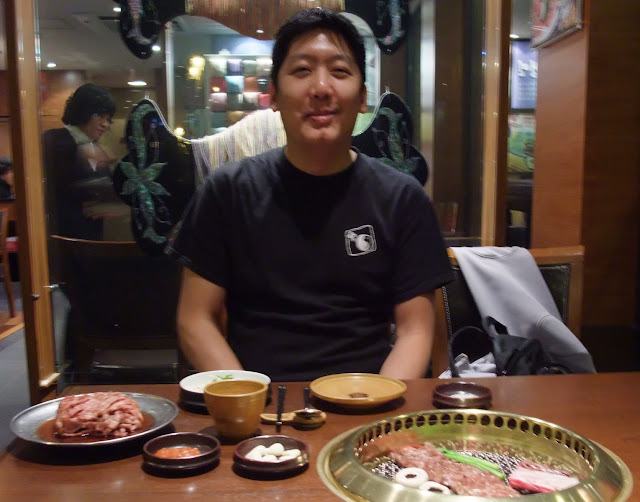How to eat Korean food
 |
| Han eagerly anticipating some of the best meat in Korea. It comes to the table raw. |
I tried to avoid Korean food on my visit to Minnesota because it's so much tastier and less expensive in Korea. However, my mom wanted to get Korean food, so I broke down and took her to Dong Yang Oriental Food. This is the only place in Minnesota that serves Korean dishes on par with Korea herself.
While very delicious and healthful, Korean food is very user-unfriendly. It is no wonder "Have you tried eating X?" is literally translated from Korean as "Do you know how to eat X?" (X를 먹을줄 알아요?) Many Korean dishes should be served with an instruction manual. For example, the first time I ordered Bibimbab I proceeded to eat it incorrectly. Bibimbab is a bowl of rice topped with various seasoned vegetables. There is a special sauce that goes with it, often served on the side. The correct way to eat Bibimbab, or literally "mixed rice," is to add the sauce, and mix everything together before eating.
If you order a meat dish in Korea, don't be surprised if you get handed a plate of raw meat (or even an octopus that is still slithering around). You'll probably also be handed a pair of scissors and tongs. The proper way to eat this is to first throw the meat onto the grill in the table, cut it up into bite-sized pieces, dip it into a little bowl of sauce, and wrap it in some greens. I highly advise the first two steps, but the last two steps are optional. (Actually, sometimes that slithering octopus is eaten without fussing with any of these steps.)
Native Koreans usually know how to eat the dishes described above, but I have witnessed even native Koreans screw up when trying to eat Dolsotbab (돌솥밥 ), or "Stonebowl Rice." As the name implies, the rice is served in a sizzling stone bowl. It is also covered with a wooden lid and served with a pitcher of scalding water and an empty bowl. How do you eat this?
- Empty most of the rice from the stone bowl into the empty bowl. Some of the the rice will be left stuck to the stone bowl.
- Add hot water to the stone bowl and cover.
- Enjoy the rice from the non-stone bowl with the rest of your meal.
- Uncover the stone bowl. Enjoy Nuleungji (누릉지), or "burnt-rice soup," for dessert.
Thank you for posting this. I never thought about a right or wrong way to eat before reading about Japanese eating and then wondered if I had offended anyone at the Korean restaurants I have been to. I love the food, and I'm glad I didn't look like a fool or slob while eating.
ReplyDelete